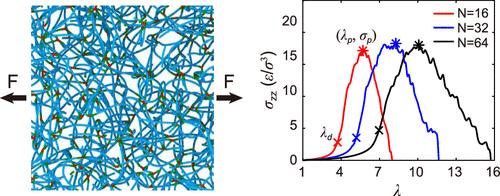非纠缠弹性体的固有拉伸强度和拉伸性
IF 5.2
1区 化学
Q1 POLYMER SCIENCE
引用次数: 0
摘要
弹性体作为三维交联聚合物网络,在广泛的应用中是必不可少的材料。强度和拉伸性是弹性体的基本力学性能,但它们是如何由网络结构决定的仍然没有得到充分的了解。在这项工作中,我们将理论分析与广泛的分子动力学(MD)模拟相结合,研究了非纠缠弹性体的单链力学和大应变力学行为。我们表明,单个聚合物链的断裂遵循由外力依赖的能量势垒Eb控制的机械化学过程。我们推导了宏观拉伸应力、网络链的构象统计和未纠缠弹性体单个链的力延伸行为之间的关系。我们的MD模拟证实了这种关系。弹性体的固有强度σinh比理论理想强度σis低1-2个数量级,这是由于在网络断裂过程中,只有一小部分链承受了显著的拉伸张力。在变形过程中,聚合物网络中最短路径(SPs)的矫直和断裂驱动了链的断裂,通过对未变形网络的拓扑SP分析可以预测标志断裂开始的临界拉伸比λd。我们的研究结果适用于具有不同链长、网络连接功能和拓扑缺陷分数的未纠缠弹性体。这项工作促进了对聚合物网络强度、损伤演化和拉伸性的基本理解,也为设计具有定制强度和拉伸性的弹性体提供了有价值的指导。本文章由计算机程序翻译,如有差异,请以英文原文为准。

Inherent Tensile Strength and Stretchability of Unentangled Elastomers
Elastomers, as three-dimensional cross-linked polymer networks, are essential materials in a wide range of applications. Strength and stretchability are fundamental mechanical properties of elastomers, but how they are determined by the network structure remains inadequately understood. In this work, we combine theoretical analysis with extensive molecular dynamics (MD) simulations to investigate the single-chain mechanics and large-strain mechanical behavior of unentangled elastomers. We show that the rupture of individual polymer chains follows a mechanochemical process governed by an external force-dependent energy barrier Eb. We derive the relationship between macroscopic tensile stress, the conformational statistics of network strands, and the force–extension behavior of individual chains for unentangled elastomers. This relationship is corroborated by our MD simulations. The inherent strength σinh of elastomers is found to be 1–2 orders of magnitude lower than the theoretical ideal strength σis, as only a small fraction of strands bear significant stretching tensions during network rupture. During deformation, strand scission is driven by the straightening and rupture of the shortest paths (SPs) in the polymer network, and the critical stretch ratio λd marking the onset of scission can be predicted through topological SP analysis of the undeformed network. Our findings hold for unentangled elastomers with varying chain lengths, network junction functionalities, and fractions of topological defects. This work promotes the fundamental understanding of the strength, damage evolution, and stretchability of polymer networks, and also provides valuable guidance for designing elastomers with tailored strength and stretchability.
求助全文
通过发布文献求助,成功后即可免费获取论文全文。
去求助
来源期刊

Macromolecules
工程技术-高分子科学
CiteScore
9.30
自引率
16.40%
发文量
942
审稿时长
2 months
期刊介绍:
Macromolecules publishes original, fundamental, and impactful research on all aspects of polymer science. Topics of interest include synthesis (e.g., controlled polymerizations, polymerization catalysis, post polymerization modification, new monomer structures and polymer architectures, and polymerization mechanisms/kinetics analysis); phase behavior, thermodynamics, dynamic, and ordering/disordering phenomena (e.g., self-assembly, gelation, crystallization, solution/melt/solid-state characteristics); structure and properties (e.g., mechanical and rheological properties, surface/interfacial characteristics, electronic and transport properties); new state of the art characterization (e.g., spectroscopy, scattering, microscopy, rheology), simulation (e.g., Monte Carlo, molecular dynamics, multi-scale/coarse-grained modeling), and theoretical methods. Renewable/sustainable polymers, polymer networks, responsive polymers, electro-, magneto- and opto-active macromolecules, inorganic polymers, charge-transporting polymers (ion-containing, semiconducting, and conducting), nanostructured polymers, and polymer composites are also of interest. Typical papers published in Macromolecules showcase important and innovative concepts, experimental methods/observations, and theoretical/computational approaches that demonstrate a fundamental advance in the understanding of polymers.
 求助内容:
求助内容: 应助结果提醒方式:
应助结果提醒方式:


